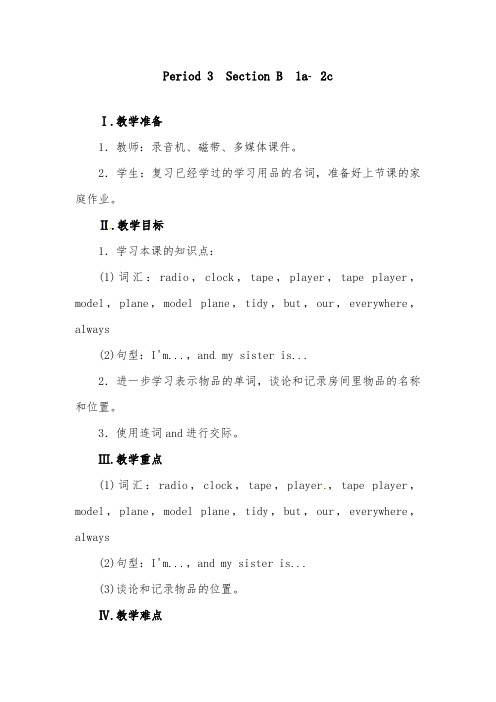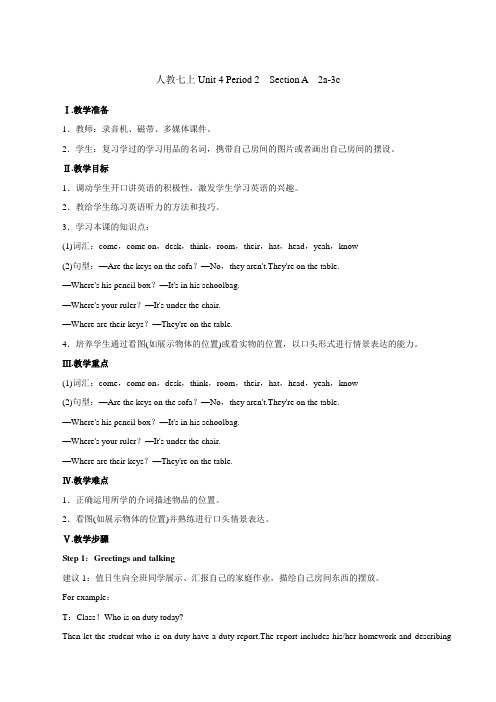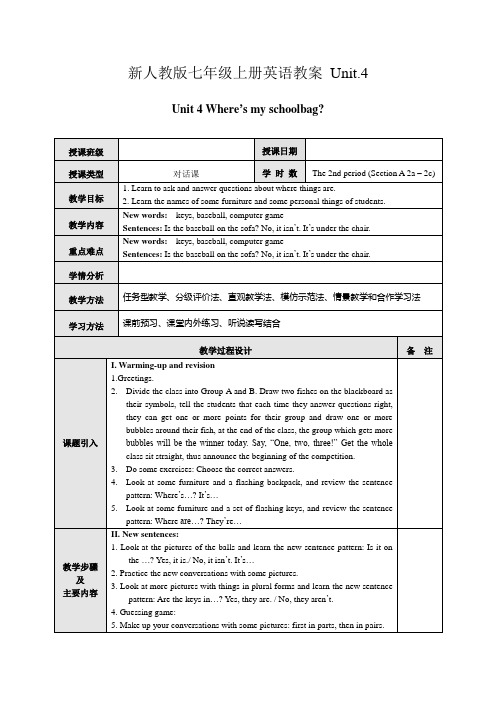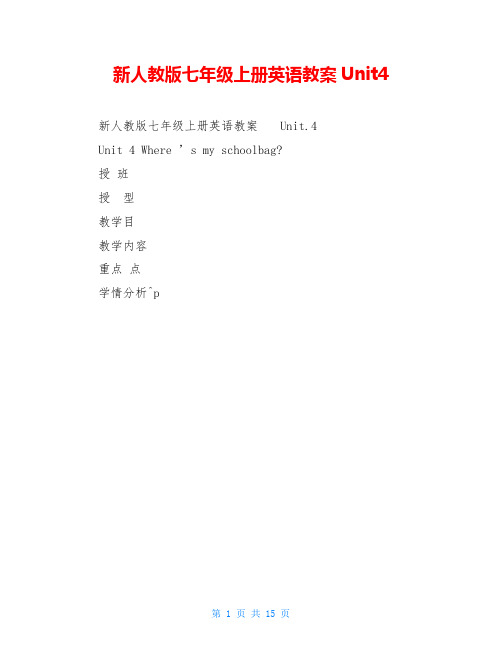2019年人教新目标英语七年级上册Unit 4 The 2nd period Section A 2a-2c优质课教案(1)
- 格式:doc
- 大小:98.00 KB
- 文档页数:5



Period 3 Section B 1a2cⅠ.教学准备1.教师:录音机、磁带、多媒体课件。
2.学生:复习已经学过的学习用品的名词,准备好上节课的家庭作业。
Ⅱ.教学目标1.学习本课的知识点:(1)词汇:radio,clock,tape,player,tape player,model,plane,model plane,tidy,but,our,everywhere,always(2)句型:I'm...,and my sister is...2.进一步学习表示物品的单词,谈论和记录房间里物品的名称和位置。
3.使用连词and进行交际。
Ⅲ.教学重点(1)词汇:radio,clock,tape,player,tape player,model,plane,model plane,tidy,but,our,everywhere,always(2)句型:I'm...,and my sister is...(3)谈论和记录物品的位置。
Ⅳ.教学难点1.阅读短文,捕捉信息。
2.表达物体的位置。
Ⅴ.教学步骤Step 1:Greetings and talking建议1:通过师生问答进行自由交际。
教师问多个学生问题,目的是为了训练学生开口说英语的能力,提高学生学习英语的兴趣。
教师在此过程中要结合本单元已经学过的“Where is the/your/his+单数名词?或Where are the/your/her...+复数名词?”句型开展大量的操练。
让学生两人一组就自己的物品及位置进行问答练习。
For example:T:Class!Let's have a revision.Practice the sentences that we have learned.Where is the/your/his+单数名词?Where are the/your/her...+复数名词?Work in pairs to practice the sentences.建议2:通过学生相互问答训练学生的口语表达能力。

人教七上Unit 4 Period 2 Section A 2a-3cⅠ.教学准备1.教师:录音机、磁带、多媒体课件。
2.学生:复习学过的学习用品的名词,携带自己房间的图片或者画出自己房间的摆设。
Ⅱ.教学目标1.调动学生开口讲英语的积极性,激发学生学习英语的兴趣。
2.教给学生练习英语听力的方法和技巧。
3.学习本课的知识点:(1)词汇:come,come on,desk,think,room,their,hat,head,yeah,know(2)句型:—Are the keys on the sofa?—No,they aren't.They're on the table.—Where's his pencil box?—It's in his schoolbag.—Where's your ruler?—It's under the chair.—Where are their keys?—They're on the table.4.培养学生通过看图(如展示物体的位置)或看实物的位置,以口头形式进行情景表达的能力。
Ⅲ.教学重点(1)词汇:come,come on,desk,think,room,their,hat,head,yeah,know(2)句型:—Are the keys on the sofa?—No,they aren't.They're on the table.—Where's his pencil box?—It's in his schoolbag.—Where's your ruler?—It's under the chair.—Where are their keys?—They're on the table.Ⅳ.教学难点1.正确运用所学的介词描述物品的位置。


新人教版七年级上册英语教案Unit4新人教版七年级上册英语教案Unit.4Unit 4 Where ’s my schoolbag?授班授型教学目教学内容重点点学情分析^p授日期学数The 2nd period (Section A 2a –2c)1.Learn to ask and answer questions about where things are.Learn the names of some furniture and some personal things of students.New words: keys, baseball, puter gameSentences: Is the baseball on the sofa? No, itisn ’t.It ’s under the chair.New words: keys, baseball, puter gameSentences: Is the baseball on the sofa? No, itisn ’t.It ’s under the ch air.教学方法学方法引入教学步及主要内容任型教学、分价法、直教学法、模仿示范法、情景教学和合作学法前、堂内外、听写合教学程注I.Warming-up and revision1.Greetings.Divide the class into Group A and B.Draw two fishes on the blackboard as their symbols, tell the students that each time they answer questions right, they can get one or more points for their group and draw one or more bubbles around their fish, at the end of the class, the group which gets morebubbles will be the winner today.Say, “ One,two, three!Get” the wholeclass sit straight, thus announce the beginning of the petition.3.Do some e_ercises: Choose the correct answers.4.Look at some furniture and a flashing backpack, and reviewthe sentencepattern: Where’s It’s?Look at some furniture and a set of flashing keys, and review the sentence pattern: Where are They’re?II.New sentences:Look at the pictures of the balls and learn the new sentence pattern: Is it on the ? ? Yes, it is./ No, it isn ’t.It ’s?Practice the new conversations with some pictures.Look at more pictures with things in plural forms and learn the new sentence pattern: Are the keys in ? ? Yes, they are./ No, they aren’t.Guessing game:Make up your conversations with some pictures: first in parts, then in pairs.堂堂小III.Listening1.Learn the new words on the first page of Unit 4.2.Word game: Show the pictures on the screen with no words.Get student to speak out their names.3.Listen and do 2a.IV .Conversations1.Get the students to look at the balls on the screen.Learn the new sentences.Where is the ball? It’s on the bo_.Where is the ball? It’s under the bo_..Where is the ball? It’s in the bo_.2.Look at the cats and read the conversations.3.Practice: Look at some pictures and practice the similar conversations.4.Look at more pictures and learn new conversations:Where are the? ? They are ?Practice with a picture with many things in both singular and plural forms.Listening1.Listen and do 1b..2.Check the answers.3.Listen for the last time and repeat.VI.Game: Find the difference1.Look at the pictures on Page 21 and Page 19, get students to find the difference.2.Show 2 pictures of rooms with some furniture: They look similar.Get students to find the difference.小与作VII.Homework1.Listen and read after the tape for thirty minutes.本作 2.Recite the conversation of Section A,3a.3.Write down the Chinese meaning of the new words and key sentences, then translate them into English.本教学后(堂理念,教学效果及改想)授班授型教学目教学内容重点点学情分析^pUnit 4 Where ’s my schoolbag?授日期巩固学数The 3rd period (Section B 1a –2b) Grasp the prepositions: on, under, in.Learn to write a note of taking or bringing things. New words: video tape, alarm clock, math book, hat Sentences: The math book is on the dresser.video tape, alarm clock, math book, hatThe math book is on the dresser.教学方法学方法引入教学步及主要内容任型教学、分价法、直教学法、模仿示范法、情景教学和合作学法前、堂内外、听写合教学程注I.Warming-up and revision1.Greetings.2.Divide the class into Group A and B.Draw two fishes on the blackboard as their symbols,tell the students that each time they answer questions right, they can get one or more points for their groupand draw one or more bubbles around their fish, at theend of the class, the group which gets more bubbles will be the winner today.Say, “ One,two, three! ”Get the whole class sit straight, thus announce the beginning of the petition.Look at some pictures and review the sentence pattern: Where ’s? ? It’s?New words:Look at the pictures of Tommy ’s room and learn the new words: math book, video tape, alarm clock, hat.And also review some words.Do 1a.Close your books and see: How many things can you remember?III.PracticeStudent A: ask questions. Student B: Keep your books closed.A: Wher e’sthe notebook?B: It ’s on the bed.IV .Listening1.Listen and do 2a.2.Check the answers.堂3.Listen and do 2b: Write sentences like this: The math book is on the dresser.Call attention to: The keys are ? (plural form)4.Listen for the last time and repeat.小与作堂小VI.Homework1.Listen and read after the tape for thirty minutes.本作 2.Recite the 6 sentences of 2b.3.Write down the Chinese meaning of the new words and key sentences, then translate them into English.本教学后(堂理念,教学效果及改想)Unit 4 Where ’s my schoolbag?授班授型教学目教学内容重点点学情分析^p授日期复学数4th period (SectionB3a — 4)Grasp the prepositions: on, under, in.Learn to write a note of taking or bringing things.New words: take, bring, needSentences: Please take these things to your sister.Can you bring some things to school? I need my hat, ?Please take these things to your sister.Can you bring some things to school?I need my hat.教学方法学方法引入教学步及主要内容堂任型教学、分价法、直教学法、模仿示范法、情景教学和合作学法前、堂内外、听写合教学程注I.Warming-up and revision1.Greetings.2.Divide the class into Group A and B.Draw two fishes on the blackboard as their symbols, tell the students that each time they answer questions right, they can get one or more points for their group and draw one or more bubbles around their fish, at the end of the class, the group which gets more bubbles will be the winner today.Say, “ One,two, three! ”Get the whole class sit straight, thus announce the beginning of the petition.3.Dictate some new words.II.Presentation:1.Show a picture of Lily, a worried girl, and some pictures of her sister and grandma:T e_plains: Lily is unhappy.She needs some things at school, but they are at home.She calls grandma.But she ’s going shopping.Her sister is playing in the park and she’s ing soon.So grandma leaves a note for her sister and asks herto take the things to Lily.Let ’s read the note.III.NotesRead the note of 3a and draw the missing things inthe picture.Check the answer.Language points : take bring First T e_plains their difference and show some e_les, then get Ss to make some sentences.How to write a note: E_plain and show a sle.课堂小结本课作业Read 3a again.Do 3b: Read and plete the note.Check the answer.Read the note of 3b.Write your own note: Get the Ss who do it quickly to read their notes.The others can do it as homework.小结与作业IV .Homework1.Listen and read after the tape for thirty minutes.2.Recite the note of 3a.3.Write down the Chinese meaning of the new words and key sentences, then translate them into English.本课教学后记(课堂设计理念,实际教学效果及改进设想)。